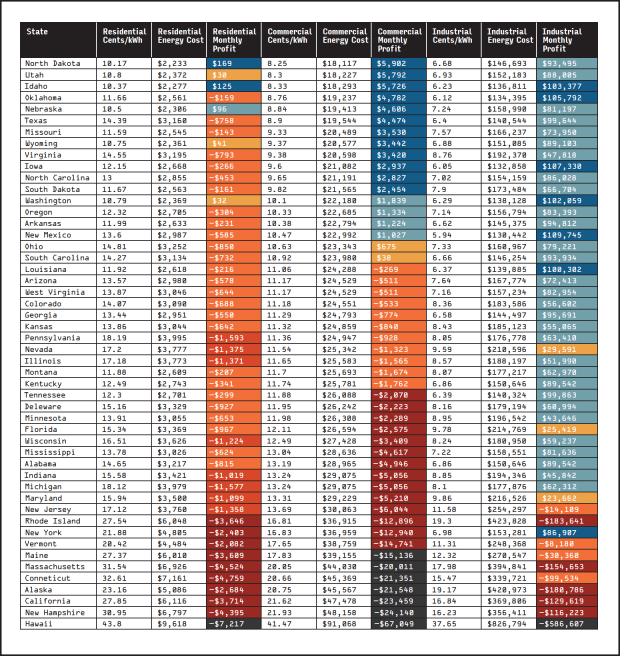The halvening is nigh, and miners are fighting for territorial advantage. Time for some Hash Recon to find the energy market high ground. From “The Primary Issue”.
This article is featured in Bitcoin Magazine’s “The Primary Issue” and is sponsored by HIVE Digital Technologies LTD as part of Bitcoin Magazine’s “Buy The Numbers” content series. Click here to get your Annual Bitcoin Magazine Subscription.
Click here to download a PDF of this article.
We’re less than 30,000 blocks out from the halvening and the stakes couldn’t be higher. For many Bitcoin mining operators, this will make or break the bets made during this Bitcoin epoch. Did I grow too fast? Can I handle a catastrophic drop in hashprice? Will my operations get rekt by my current energy contract? Bitcoin itself remains indifferent. The halvening is inevitable, encoded by Satoshi at Bitcoin’s genesis and enforced by nodes across the world. The blocks will continue to flow and there will be blood. The big question many are asking is how to weather this looming battle. Perhaps the better question is where to be positioned on the board when the battle happens. It’s one thing to know how to build and operate an efficient fleet of bitcoin miners, but the critical success factor remains energy cost. It comes down to your position on the map. In order to find the higher ground, you must perform hash recon.
This halvening event will challenge even the most battle-hardened veterans. They will need to optimize their operations at all costs. For inexperienced operators, energy cost might seem like a variable that you can overlook. They solely focus on stacking as much hashrate as possible and tend to altogether forget about efficiency — the energy consumed per hash produced. In the long run, energy cost is the most important variable. Sure, your dollars per terahash are important, the bitcoin price is important, and so is network hashrate. It’s all important. But energy cost is the kingmaker. Afterall, the 7-year-old, legendary Antminer S9 is still profitable today with cheap enough energy.
 Click the image above to subscribe!
Click the image above to subscribe!
At the heart of miners’ considerations are two foundational elements: mining revenue and energy expenses. These two variables are used to quickly run the numbers on mining profitability. It’s important to note that this does not take into account the additional operating costs like labor and other associated expenses that go into running a mine. It remains a useful formula for keeping the lights on.
Mining operators come in many different sizes, and the easiest way to distinguish them is based on how much power they are using. Here in the U.S., the Energy Information Administration (EIA) is responsible for monitoring energy trends and categorizes consumption and power costs into Residential, Commercial, and Industrial customer power rates. We will focus on how mining operators would profit on the applicable rates across each of these three categories:
Residential: <30 kW — Encompassing home miners with 1 to 10 bitcoin mining machines. Typical homes cannot handle much more energy than this and would require additional electrical infrastructure being installed. Residential scale has the highest energy rates within the same state. Commercial: 30 kW-1 MW — Covering small to medium-sized business and bitcoin mining operators with 10 to 300 mining machines. The Commercial scale range is characterized by energy consumption that is larger than Residential but not quite Industrial scale. This range is typically up to 1 MW in size. While commercial-scale miners have better rates than residential customers within the same state, they are not big enough to successfully negotiate with power companies.Industrial: >1 MW — Operations with more than 300 mining machines. Industrial-scale operators are large enough consumers of power that they can negotiate energy costs via power purchase agreements and acquire energy at the lowest cost within the same state.Despite these variations in scale, all three categories of mining operators are united by a common need for cost-efficient power. While some miners may be limited by geographical constraints, enterprising miners are actively exploring regions with affordable energy rates — we’ll call that jurisdictional arbitrage — while others are trying to scale into situations where they are large enough to have a seat at the table to negotiate lower rates.
War Games
Now that we have a better understanding of what different scale operations look like, let’s run the numbers. Since we don’t have the benefit of a crystal ball, we will simulate a war game using the following data points:
BTC price at $30,000.Network hashrate at 400EH/s.Bitmain Antminer S19j Pro 100TH/s at 3kW per unit.Residential scale: 10 Bitcoin Miners.Commercial scale: 100 Bitcoin Miners.Industrial scale: 1000 Bitcoin Miners.Energy rates at 2023 YTD (EIA).Let’s apply our simple mining profitability formula (mining revenue minus power cost) to see how mining operators would handle this scenario across the U.S.


Running the numbers is quite sobering, as you immediately see just how unprofitable mining is under our outlined scenario. Only 40 states are profitable at industrial rates, 18 with commercial rates, and six states at residential rates. If you run this same simulation but enforce a halving, cutting your daily mining revenue in half, it’s suddenly a doomsday scenario where no mining operation would be profitable. Of course, Bitcoin doesn’t exist within a vacuum, and this doesn’t account for changes in the network hashrate and the bitcoin price.
The war game looks bleak for operators at residential scale. With outlined conditions, profitability at residential energy rates appears elusive and mining operations are likely running at a loss nationwide. While some may pursue this path to accumulate KYC-free sats, for many, this does not justify operating at a deficit.
Commercial rates offer a more promising outlook for operators, as lower energy costs extend profitability into many more states. Still, only a few states provide a profitable environment for small and medium-sized business miners, especially in the potentially challenging year of 2024.
 Click the image to download a PDF of the article.
Click the image to download a PDF of the article.
The landscape shifts further at the industrial scale, where miners wield more influence and earn a proper seat at the table. Energy producers take notice when operators’ demand approaches or exceeds 1MW, reflecting a transition from being a rounding error to a meaningful consumer. While profitability is possible in 40 states for industrial-scale miners, several states remain challenging.
The question is whether mining operators will be able to survive the battle to fight another day. Enduring an onslaught of increased competition, the halving, and an ever-unpredictable bitcoin price will not be easy. Operators will need to find efficiencies where they can. This fundamental principle holds true: Profitability can be achieved with sufficiently low hardware and energy costs. The big headline in this whole piece is that the geographic location of your operation is probably the most critical success factor in running a mining operation. For a majority of the country, this means you should not plug in bitcoin miners. However, there are still opportunities out there if you are ambitious enough to get in the trenches and do hash recon. This is where stripes are earned and the high ground is claimed.
This article is featured in Bitcoin Magazine’s “The Primary Issue” and is sponsored by HIVE Digital Technologies LTD as part of Bitcoin Magazine’s “Buy The Numbers” content series. Click here to get your Annual Bitcoin Magazine Subscription.
Click here to download a PDF of this article.


















